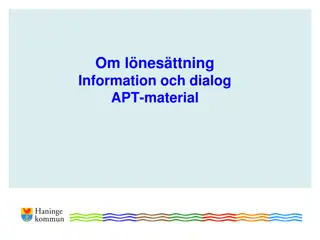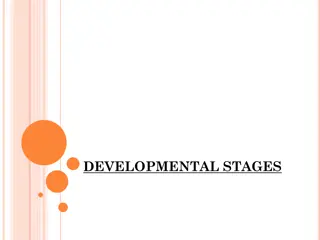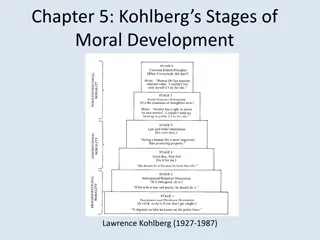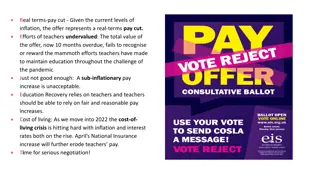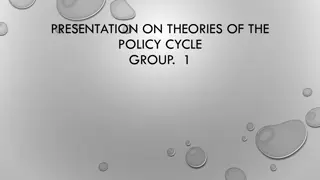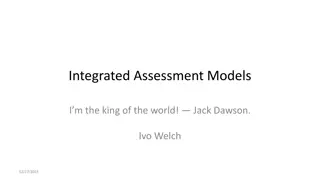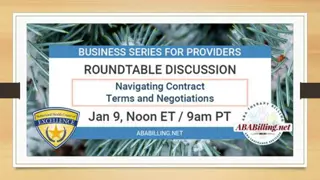Mastering the Art of Policy Negotiations: Key Stages and Strategies
Dive into the intricacies of policy negotiations with a comprehensive overview of the major stages, diverse approaches, and the role of negotiation in the policy cycle. Understand the importance of cooperative negotiating, different negotiation scopes, and the fundamental principles guiding effective negotiations. Explore the dynamic process, from understanding the problem to reaching a proposed agreement, with a focus on stakeholder engagement and strategy development.
Download Presentation

Please find below an Image/Link to download the presentation.
The content on the website is provided AS IS for your information and personal use only. It may not be sold, licensed, or shared on other websites without obtaining consent from the author.If you encounter any issues during the download, it is possible that the publisher has removed the file from their server.
You are allowed to download the files provided on this website for personal or commercial use, subject to the condition that they are used lawfully. All files are the property of their respective owners.
The content on the website is provided AS IS for your information and personal use only. It may not be sold, licensed, or shared on other websites without obtaining consent from the author.
E N D
Presentation Transcript
POLICY NEGOTIATIONS 8 MODULE 8 Negotiating for Health
LEARNING OBJECTIVES 8 List the major stages of the negotiation process 1 Describe the several approaches to policy negotiation 2 Explain the characteristics of cooperative or value-added negotiating 3
THE SCOPE OF NEGOTIATING 8 Negotiating out whole-of-society Negotiating across whole-of-government Negotiating within health
POLICY NEGOTIATION DEFINITION 8 Negotiation is a process by which two or more parties seek an agreement to establish what each shall give or take, or perform and receive in transaction between them. - Saner 2011 It is a process of making a joint decision when parties involved have different preferences, interests and drivers. Many approaches to negotiation.
THE PLACE OF NEGOTIATION IN THE POLICY CYCLE 8 REVIEW AGENDA SETTING Report Identify problem Evaluate Research Monitor Set agenda IMPLEMENTATION FORMULATION Enforce policy Develop options and strategies Implement policy Negotiate Formulate policy Source: modified from http://www.geostrategis.com/images/policycycle.jpg
8 PRINCIPLES OF NEGOTIATION Two or more parties Convergent or divergent interests Voluntary relationship Distribution or exchange of tangible or intangible resources Dynamic process Incomplete information Alterable values or positions as affected by persuasion and influence
8 STAGES OF NEGOTIATION PROCESS 1 Understanding a problem raised in agenda setting 2 Identify stakeholders and their interests 3 Consult with stakeholders 4 Establish negotiation agenda 5 Develop positions and strategies 6 Negotiate with stakeholders 7 Assess proposed agreement
8 STAGES OF NEGOTIATION PROCESS Understanding a problem raised in agenda setting 1 Negotiations occur after a problem or opportunity has been identified, which corresponds to the agenda-setting stage of the policy cycle. Preparation is vital understand the problem or issue you are dealing with. Consider whether negotiations are necessary or possible.
8 STAGES OF NEGOTIATION PROCESS 2 Identify stakeholders and their interests Once the problem is well understood, one has to identify who may benefit and who may lose in the negotiation. Determine if there are any powerful interest groups that may either support or oppose the negotiations. Undertake a stakeholder analysis.
8 STAGES OF NEGOTIATION PROCESS 3 Consult with stakeholders Plan and organize an effective consultation process to further understand the needs of stakeholders. Gather information to develop a negotiating agenda. Determine a position on each issue to be negotiated.
8 STAGES OF NEGOTIATION PROCESS 4 Establish negotiation agenda Before negotiations can begin an agenda defining the issues open for discussion is usually agreed upon by the parties. Decide upon a format for the process, including location, timing and resources for facilitation.
8 STAGES OF NEGOTIATION PROCESS 5 Develop positions and strategies Steps involved in developing a negotiating strategy may include: Establishing outcomes and priorities for oneself; Estimating outcomes and priorities for other parties; Identifying and assessing major trade-offs; and Constructing and evaluating as many possible combinations of outcomes and consequences.
8 STAGES OF NEGOTIATION PROCESS 6 Negotiate with stakeholders Stakeholders implement their strategies, propose agreements, offer concessions and compromises are reached. The chosen negotiation strategies of the stakeholders will heavily influence the tone of the discussions and the potential agreements that can be reached.
8 STAGES OF NEGOTIATION PROCESS 7 Assess proposed agreement After the actual negotiation has finished and an agreement has been put forward, an evaluation of the outcomes becomes necessary to decide whether a successful agreement is possible or whether another round of negotiations might be needed. Individuals external to the negotiation (e.g. technical experts, lawyers) might be involved in making an assessment to ensure the proposed agreement is legal and viable.
8 APPROACHES TO NEGOTIATIONS THERE ARE FOUR MAIN APPROACHES TO POLICY NEGOTIATION Assertive Cooperative Competitive Assertiveness Haggling Avoidance Unassertive Uncooperative Cooperation Cooperative Source: Thomas KW and Kilmann RH (1977) Developing a forced-choice measure of conflict handling behaviour: the mode instrument. Educational and Psychological Measurement, 37.
8 APPROACHES TO NEGOTIATIONS COMPETITIVE MAXIMIZE ONE S GAINS AND MINIMIZE CONCESSIONS TO OTHER PARTIES. Assertive Cooperative Competitive Assertiveness Haggling Avoidance Unassertive Uncooperative Cooperation Cooperative
8 APPROACHES TO NEGOTIATIONS HAGGLING LIES SOMEWHERE BETWEEN THE COMPETITIVE AND COOPERATIVE APPROACHES; AIMS TO SECURE A PRE-DETERMINED POSITION BY MAKING TRADE-OFFS OR CONCESSIONS. Assertive Cooperative Competitive Assertiveness Haggling Avoidance Unassertive Uncooperative Cooperation Cooperative
8 APPROACHES TO NEGOTIATIONS AVOIDANCE AIM IS TO DEFER OR POSTPONE DECISIONS ON DIFFICULT OR UNFAVOURABLE ISSUES. Assertive Cooperative Competitive Assertiveness Haggling Avoidance Unassertive Uncooperative Cooperation Cooperative
8 APPROACHES TO NEGOTIATIONS COOPERATIVE SEEKS MUTUAL GAINS FOR ALL PARTIES BY JOINT PROBLEM SOLVING. Assertive Cooperative Competitive Assertiveness Haggling Avoidance Unassertive Uncooperative Cooperation Cooperative
ADDITIONAL NEGOTIATION TECHNIQUES FOR A HiAP APPROACH 8 SOME ADDITIONAL TECHNIQUES FOR EFFECTIVE NEGOTIATING IN A HiAP CONTEXT INCLUDE: Study the problem in detail and analyze stakeholders thoroughly; Anticipate and respond to objections; State objectives or interests rather than positions; Present multiple proposals; Listen carefully for what is said, what is not said and watch body language; Remain assertive but not aggressive; Use body language knowingly to communicate; and Keep proposals as simple as possible; Persist with negotiations in goodwill but walk away if necessary. Articulate ideas and arguments concisely; Assume the best of other stakeholders;
End of Module 8 Please continue to Module 9



